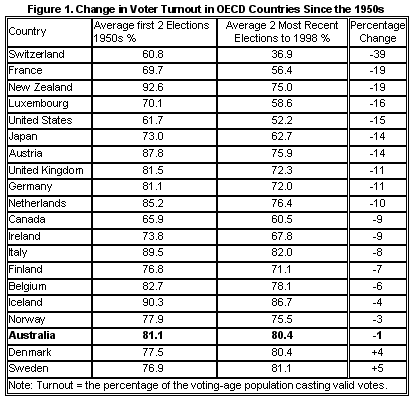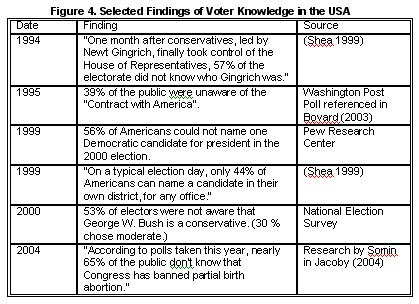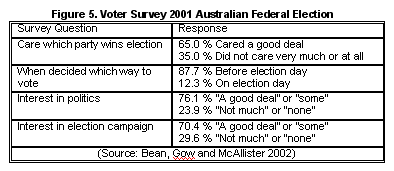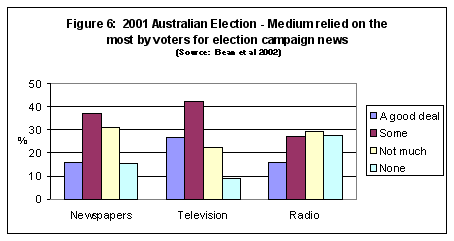There has been much discussion recently about compulsory voting, brought to a focus recently (October 4, 2005) in a speech to the Sydney Institute given by the federal minister responsible for electoral matters, Senator Eric Abetz. The Australian’s Mike Steketee gives a good rundown of the machine politics here.
As much as some politicians would like to make voting voluntary in Australia, the fact that pollster Gary Morgan found that 71 per cent of Australians support compulsory voting, a level that has been maintained for the past 40 years, means the obligation to vote is deeply set into the Australian psyche. Certainly John Howard is not game to take the Australian people on over this.
But what difference does compulsory voting make? Do we vote in greater numbers than comparable countries where voting is voluntary, and are we better informed about the candidates and issues? This paper takes a brief look at some international comparisons and finds the answer to both these questions is “yes” but to a lesser degree than perhaps some may expect.
Advertisement
Voter turnout
A comparative study by Martin Wattenberg from the University of California shows that, in a range of OECD countries, turnout in 1998 was the lowest recorded in the post-war period. Figure 1 illustrates a decline that according to Wattenberg, “is rare in comparative politics to find a trend that is so widely generalizable.”

But my view is that things are not as bad everywhere as many writers might portray. Figure 2 presents the 1998 data in chart form and it can be seen that most of the countries are either on or above the OECD mean of 70.1 per cent.

And 70 per cent for any country is, I think, pretty good - particularly when you are asking people to do something for which they receive no discernable benefit to the individual except a warm inner glow. Much of the bad press comes from the United States of America and Canada where rates are low and that seems to have unduly influenced the literature. Figure 3 gives a breakdown of the most recent Australian federal election held in 2004.

Advertisement
The first thing it tells us is that 15 per cent of the eligible population do not even enroll to vote. Then we lose another 5 percent on ballot day because that number, even though enrolled, fail to attend a voting booth. After we allow for 4 per cent lost to informal voting, we are down to three quarters of the eligible population actually lodging a valid vote on election day. John Howard’s conservatives were therefore elected by 39 per cent of the adult population (52 per cent of 76).
My observation is that compulsory voting makes a difference to turnout, but not as much as many people think. Compulsory voting gives a relatively high level of informal votes (most countries have levels well below 1 per cent), which brings Australia back to the pack even more. After informals are removed, Australia’s “true” participation rate is about 76 per cent, which is not that far above the OECD mean of 70 per cent.
Voter knowledge
So, if a legal compulsion to vote is not the prime motivator, why do large portions of the world’s population bother? There is plenty of evidence that voters around the world are ignorant of politics and politicians, so it can’t be any great public interest in the policy debates. Again it is interesting to compare the US with Australia. Figure 4 summarises some recent findings in the US in regard to voter knowledge. It shows that American voters tend to be ignorant on even the most basic of issues.

By comparison, Figures 5 and 6 show some relatively high scores on Australian voter knowledge and interest, which indicates that some synthesis, analysis and comparison of candidates and policy issues must have been undertaken by voters.


The above data show a generally high level of engagement in political issues by the majority of voters, but what of the depth of knowledge? Ian McAllister undertook a study in 2001 leading him to suppose that, “by any standards, levels of political knowledge in the electorate are low.” Based on analysis of a survey of voters in the 1997 Australian federal election he found that the median voter could only answer correctly two out of seven factual statements about political institutions.
But not all of McAllister’s observations were that damning. He also asked respondents if they knew the name of their federal member prior to the election. Seventy per cent correctly gave the name of the member and 61 per cent the correct name of the party. This is an interesting finding, because it appears not to be consistent with the experiences in the US. Figure 4 shows only 44 per cent of Americans could name an election candidate. This is not exactly the same question, but close enough to indicate that Australians are more knowledgeable about who their candidates and parliamentarians are.
Rational ignorance
The picture emerges, perhaps, of the Australian voter who is not as politically ignorant as his or her counterparts in some western democracies, particularly in countries like the US where the turnout rates are low. But attempting to put a “level” on the extent of ignorance or knowledge is a hard task. Determining what the voter should know, the point at which knowledge can be considered sufficient, and how it should be measured, is patronising to the public and something we perhaps should not attempt.
Rabinowitz and MacDonald (1989) are among those who question whether voters weigh up issue alternatives in an empirical way, in the sense that they choose between policy tradeoffs. Rabinowitz and MacDonald accept that the ignorant voter exists, to the extent that voters operate with low levels of information, but reject the notion that the voter acts within a rational choice framework.
It is clear that a person acting “rationally” does not vote in order to exert an influence on the outcome as one vote cannot possibly make any difference amongst thousands. But people do vote, so there is a reward there somewhere. Some no doubt enjoy the feeling of participation in a crowd - voting as an event. Some like to express an opinion, even if they keep it to themselves, and many I am sure do so out of “civic duty” on the belief that to not vote would bring a detriment to democracy. This last point does not stand, logically speaking, as the abstention of one individual excerpts no perceptible influence on the system. But people believe it anyway. Australians, as do many other nationalities, appear to believe it is their moral duty to vote (although one could just as readily mount an argument that it is one’s moral duty not to vote, but that is a discussion for another day).
Summary
Putting all the above together, what influence does compulsory voting have on Australians? First, it puts us up with the leaders when it comes to voter turnout, but by no means way out in front. After taking high levels of non-registration and informal voting into account, voter participation in Australia only just exceeds OECD averages.
And it does appear that, compared to many countries, Australian elections are characterised by higher levels of citizen engagement in politics, higher public awareness of policy options, and generally a belief by voters that their vote is important.
But all this is relative. It is difficult to escape the conclusion that Australia’s elections are decided by at least a sizable portion of the electorate that does not know about political issues and does not care. They care about their duty to vote but do not necessarily go to the ballot box armed with much knowledge; but whether any voter in a modern democracy can ever have enough information to know all they need to know on all issues is highly unlikely. No one acting rationally could invest the time and effort needed to fully analyse all policy issues so, to an extent, all voters are politically ignorant. What might be concluded is that the Australian voter is somewhat less ignorant - or somewhat more knowledgeable, take your pick - than voters in many western democracies.